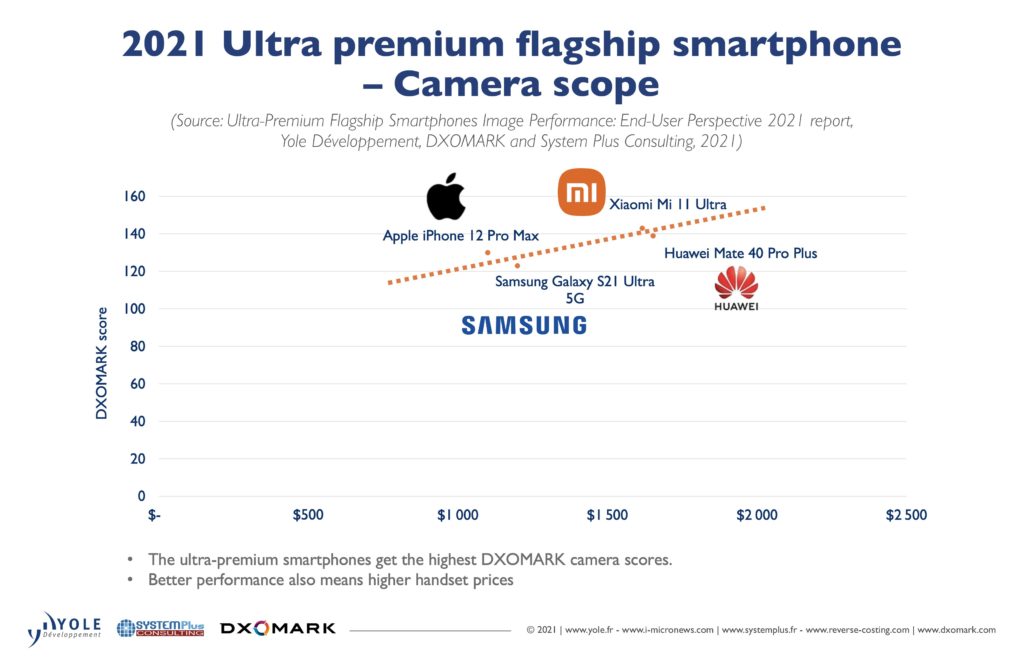This market research report was originally published at Yole Développement’s website. It is reprinted here with the permission of Yole Développement.
Yole Développement (Yole), DXOMARK, and System Plus Consulting combine their expertise to analyze the performance of the latest ultra-premium flagship smartphones in a new dedicated report.
OUTLINE:
-
Hardware & chipset
Great photos and videos: large camera modules and new HDR sensor technologies are now widely used, especially in video.
Zoom function: more camera modules are showing better sensitivity at each focal length.
A better user experience: HDR sensor technologies have been developed to offer better WYSIWYG capabilities.
-
Software & integration
Huawei and Xiaomi: for photos and videos, their smartphones offer denoising and better HDR capabilities.
They also provide a super resolution and fusion algorithm to support a consistent zoom quality.
AI technologies enable a faster simulation of the final still image quality, from an end-user perspective.
-
Image quality
Both OEMs , Huawei and Xiaomi, combine great hardware and software solutions to enhance the photo and video functions.
The smartphone industry has for long been the theater of an arms race between the major OEMs. Every year, imaging capabilities improve and are at the forefront of the OEM’s branding, as imaging has become one of the biggest differentiating factors between OEMs.
Yole Développement (Yole), DXOMARK, and System Plus Consulting today combine their technical and market knowledge to deliver a significant and unique analysis of the latest ultra-premium flagship smartphones and their performances: Ultra-Premium Flagship Smartphones Image Performance: End-User Perspective 2021 report.
This analysis is built on DXOMARK’s unique testing capabilities and detailed scientific test reports.
“At DXOMARK, we’ve been evaluating products from the end user perspective for more than ten years”,says Frederic Guichard, CEO & CTO of DXOMARK. “Today, we’re thrilled to announce our partnership with Yole Développement and System Plus Consulting, bringing a unique and comprehensive understanding to industry watchers and the smartphone ecosystem of the elements that drive quality, from market trends to components to the actual user experience”.
“The Ultra-Premium Flagship Smartphones Image Performance: End-User Perspective 2021 report is the first collaboration between the three companies, Yole Développement, DXOMARK, and System Plus Consulting”, explains Jean-Christophe Eloy, President & CEO of Yole Développement. “Today, this partnership seems obvious: we share our visions of the imaging industry, from devices to end-systems, to deliver valuable results and insights to our customers. By combining our expertise, we highlight the latest technical innovations and make the link with the OEMs’ strategies.”
In the Ultra-Premium Flagship Smartphones Image Performance: End-User Perspective 2021 report, analysts selected four leading flagships that have brought major improvements to the user’s experience: the Apple iPhone 12 Pro Max, the Samsung Galaxy S21 5G Ultra (snapdragon), the Huawei Mate 40 Pro, and the Xiaomi Mi 11 Ultra. For each smartphone, they measured the photo and video performance, and developed dedicated teardowns to identify the technical choices made by each OEM and how they translated in terms of end user experience.

According to Hervé Macudzinski, Image Science Director at DXOMARK: “This study delivers the overall DXOMARK score for each of these four flagships and behind that a unique understanding of the technological selections made by the leading OEMs, Apple, Samsung, Huawei, and Xiaomi. The performance of these four iconic smartphones has been detailed in terms of various features and attributes: exposure, color, autofocus and depth of field, texture and noise, bokeh, night, preview, and tele-zoom.”
Performance of each attribute is further explained and illustrated in detail for both photo and video use cases, with an underlying explanation and many illustrations. This will allow the reader to reach a proper understanding of the technical choices of OEMs and the repercussions of these choices in semiconductor content, assembly challenges, and end-user performance.
The most significant results were not necessarily the most obvious, announced the partners, Yole, DXOMARK, and System Plus Consulting.
“All OEMs aim to deliver the very best photo & video experience to the end-user,” asserts Zine Bouhamri, Ph.D., Team Lead Analyst, Imaging & Display, Yole Développement. He adds: “Choices are endless between camera setups, functionalities, and specifications. From hardware to software tuning by OEMs, different choices lead to different results for the end-user.”
For instance, packing more pixels does not necessarily translate into better image quality. While Samsung includes a 108MP sensor on their early 2021 flagship, Apple, with its iPhone 12 Pro Max, although choosing a lower resolution, ended up with a higher DXOMARK score. Regarding hardware specifically, Huawei and Xiaomi combine great hardware – including larger camera modules – with excellent software integration, while Apple provides very high-quality images despite their smaller camera module, thanks to its combination of hardware and software.

The crucial complementarity between hardware and software is highlighted in HDR measurements. This feature has been around for a long time, but still huge differences appear without exceptional hardware and software integration – even among flagships.
With this new phase opening up with the iPhone 13 Pro Max, Yole, DXOMARK, and System Plus Consulting expect OEMs to continue adopting these balanced hardware architectures while continuously improving their software solutions to further enhance end-user performance.
Yole, DXOMARK, and System Plus Consulting expect more collaborations and analyses in the near future. Stay tuned!
Discover the online event powered by the three partners on i-Micronews.com: Smartphone flagship battle: from sensors to modules to image quality – Recorded webcast. Speakers:
- Chenmeijing Liang, Technology & Market Analyst, Yole Développement (Yole)
- Peter Bonnano, Technology & Cost Analyst, System Plus Consulting
- Hervé Macudzinski, Image Science Director at DXOMARK.
Extracted from:
- Ultra-Premium Flagship Smartphones Image Performance: End-User Perspective 2021 report, Yole Développement, DXOMARK and System Plus Consulting, 2021
Acronyms:
- HDR: High Dynamic Range
- WYSIWYG: What You See Is What You Get
- OEM: Original Equipment Manufacturer


